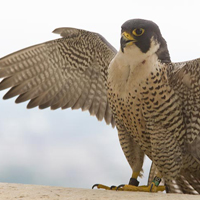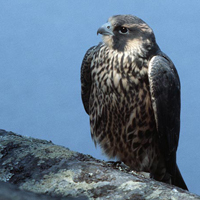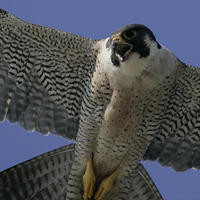Peregrine falcon
Scientific name: Falco peregrinus



Photos: Doug Wechsler/VIREO (left), MNRF (middle), and Doug Wechsler/VIREO (right)
Status
Special Concern
“Special Concern” means the species lives in the wild in Ontario, is not endangered or threatened, but may become threatened or endangered due to a combination of biological characteristics and identified threats.
Date added to the Species at Risk in Ontario List
November 30, 2011
Read the most recent assessment report (PDF)
What it looks like
This is one of Canada’s most well known species at risk, owing to almost 50 years of public attention and conservation efforts.
The Peregrine Falcon is a crow-sized bird with a slate blue back and a cream-coloured chest covered in dark markings. Peregrine Falcons have pointed wings that span about one metre, a narrow tail and adults have a prominent black “moustache.” The dark feathers on the falcon’s head make the bird look like it’s wearing a helmet. Another distinguishing feature of this falcon is its bright yellow feet and legs. Peregrine Falcons have sharp talons and pointed hooked bills that make them good hunters. Juvenile peregrines appear darker than the adults. As with most birds of prey, the female is much larger than the male.
Where it lives
Peregrine Falcons usually nest on tall, steep cliff ledges close to large bodies of water. Although most people associate Peregrine Falcons with rugged wilderness, some of these birds have adapted well to city life. Urban peregrines raise their young on ledges of tall buildings, even in busy downtown areas. Cities offer peregrines a good year-round supply of pigeons and starlings to feed on.
Where it’s been found in Ontario
This species is widely distributed, found on every continent, except Antarctica. The historic North American distribution of the eastern subspecies is east of the Rocky Mountains and south of the tree line. Although Peregrine Falcons now nest in and around Toronto and several other southern Ontario cities, the majority of Ontario’s breeding population is found around Lake Superior in northwestern Ontario.
View a larger version of this map (PDF)
What threatens it
In the 1950s, peregrine numbers began to drop, and by the mid 1960s, the falcon had disappeared from Ontario. Eventually, it was discovered that the pesticide DDT was responsible for the birds’ decline.
The very real possibility of the birds’ extinction caused worldwide concern, and led to major recovery efforts across North America. The Peregrine Falcon came to symbolize the plight of many species threatened by pollution.
Today, the Peregrine Falcon faces many of the same threats facing other species at risk: habitat loss and destruction, disturbance and persecution by people, and environmental contaminants.
Action we are taking
Special concern species do not receive species or habitat protection.
Recovery strategy
A recovery strategy advises the ministry on ways to ensure healthy numbers of the species return to Ontario.
Read the executive summary and full document (February 18, 2010).
Government response statement
A government response statement outlines the actions the government intends to take or support to help recover the species.
Read the government response statement (November 18, 2010).
Five-Year Review of Progress
A five-year review reports on progress made toward protecting and recovering a species, within five years of publishing a species’ government response statement.
Read the report on progress towards the protection and recovery of 13 species at risk, including Peregrine Falcon (2015)
What you can do
Report a sighting
- If you spot a Peregrine Falcon, you can report your sighting to the Natural Heritage Information Centre, which tracks and maintains a database of many of Ontario’s wild species.
- Learn all you can about the Peregrine Falcon, other raptors and species at risk in Ontario. Visit the Canadian Peregrine Falcon website for a list of webcams featuring Peregrine Falcon nests in Ontario.
- If you find an injured Peregrine Falcon, contact the MNRF to find your nearest district office. Staff can direct you to a licensed wildlife rehabilitator. Call toll free:
1-800-667-1940
Volunteer
- Volunteer with your local nature club or provincial park to participate in surveys or stewardship work focused on species at risk.
Be a good steward
- Private land owners have a very important role to play in species recovery. You may be eligible for stewardship programs that support the protection and recovery of species at risk and their habitats.
- Avoid using pesticides to control pigeons as they may harm the Peregrine Falcons from nearby nests. Use nonlethal methods whenever possible.
Report illegal activity
- Report any illegal activity related to plants and wildlife to
1-877-TIP-SMNR (847-7667) .
Quick facts
- Captive-breeding programs have played a large role in restoring wild peregrine populations throughout Canada. Ontario’s release program was phased out in 2006, as most populations are now stable or increasing.
- Young Peregrine Falcons have a high mortality rate. 70% of peregrines don’t make it past their first year. Those that do survive, however, can live up to 15 years.
- Young falcons (the group of birds that includes peregrines, kestrels, merlins, and gyrfalcons) are called “eyasses.”
